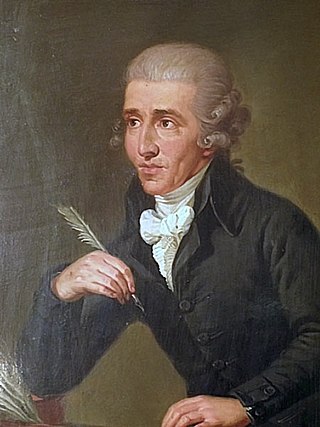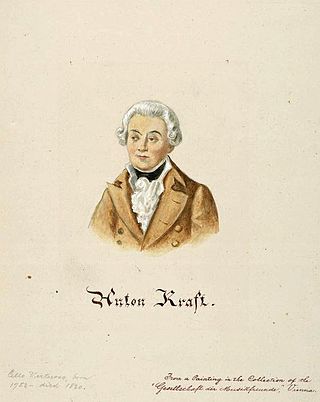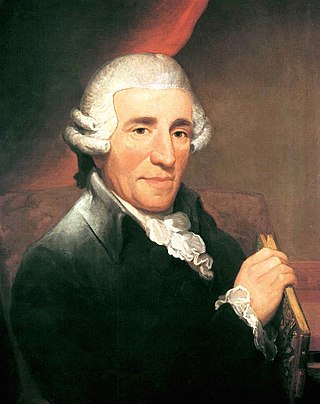Related Research Articles

Johann Christoph Friedrich Bach was a German composer and harpsichordist, the fifth son of Johann Sebastian Bach, sometimes referred to as the "Bückeburg Bach".

A violin concerto is a concerto for solo violin and instrumental ensemble. Such works have been written since the Baroque period, when the solo concerto form was first developed, up through the present day. Many major composers have contributed to the violin concerto repertoire.
E-flat major is a major scale based on E♭, consisting of the pitches E♭, F, G, A♭, B♭, C, and D. Its key signature has three flats. Its relative minor is C minor, and its parallel minor is E♭ minor,.

The Cello Concerto No. 1 in C major, Hob. VIIb/1, by Joseph Haydn was composed around 1761-65 for longtime friend Joseph Franz Weigl, then the principal cellist of Prince Nicolaus's Esterházy Orchestra.

Václav Pichl was a Czech classical composer of the 18th century. He was also a violinist, music director and writer.

Antonín Kraft was a Czech cellist and composer. He was a close friend of Haydn, Mozart, and Beethoven. He worked in the Holy Roman Empire and later in the Austrian Empire.
An organ concerto is an orchestral piece of music in which a pipe organ soloist is accompanied by an an orchestra, although some works exist with the name "concerto" which are for organ alone.
The Violin Concerto No. 3 in A major was composed by Joseph Haydn probably between 1765 and 1770.

The Violin Concerto No. 4 in G major by Joseph Haydn is one of the composer's three surviving violin concertos.
Homotonal (same-tonality) is a technical musical term that describes the tonal structure of multi-movement compositions. It was introduced into musicology by Hans Keller. According to Keller's definition and usage, a multi-movement composition is 'homotonal' if all of its movements have the same tonic (keynote).
Joseph Haydn's Horn Concerto No. 1 in D major, was completed in 1762, "when Haydn was new to the Esterhazy court."

Joseph Haydn's Cello Concerto No. 2 in D Major, Hob. VIIb/2, Op. 101, was for many years thought to have been composed in 1783 for Antonín Kraft, a cellist of Prince Nikolaus's Esterházy Orchestra. New research, published in 2019 by Thomas Tolley and building on discoveries of Simon McVeigh, shows it was neither written for nor debuted by Kraft, an assertion that was made by Kraft's son to musicologist Gustav Schilling, and later repeated in Schilling's influential musical encyclopedias. However, original advertisements in the London press announced that ‘A new Concerto, Violoncello, Mr Cervetto, composed by Haydn’ had its premier on March 24, 1784 at Hannover Square. A second performance was advertised a week later as being a ‘Concerto Violoncello, Mr Cervetto, composed by Haydn’. The C major concerto, Haydn's only other cello concerto, was, at this point, more than twenty years old. The soloist of the premiere, James Cervetto, was the principal cellist of the Italian Opera in London and one of England’s leading solo cellists. It is regarded as one of the greatest works for cello of the classical era.
A double concerto is a concerto featuring two performers—as opposed to the usual single performer, in the solo role. The two performers' instruments may be of the same type, as in Bach's Double Violin Concerto, or different, as in Brahms's Concerto for Violin, Cello and Orchestra.

Joseph Haydn wrote 123 trios for the unusual combination of baryton, viola and cello. Three further trios for baryton, cello and violin are considered part of the series. As Sisman notes, they are the “most intensively cultivated genre” of Haydn’s early career.
References
- The New Grove Encyclopedia of Music and Musicians offers a complete list, with the current best-estimate dating, of Haydn's concertos and other works. The listing is repeated in the spin-off volume by Webster and Feder, The New Grove Haydn.